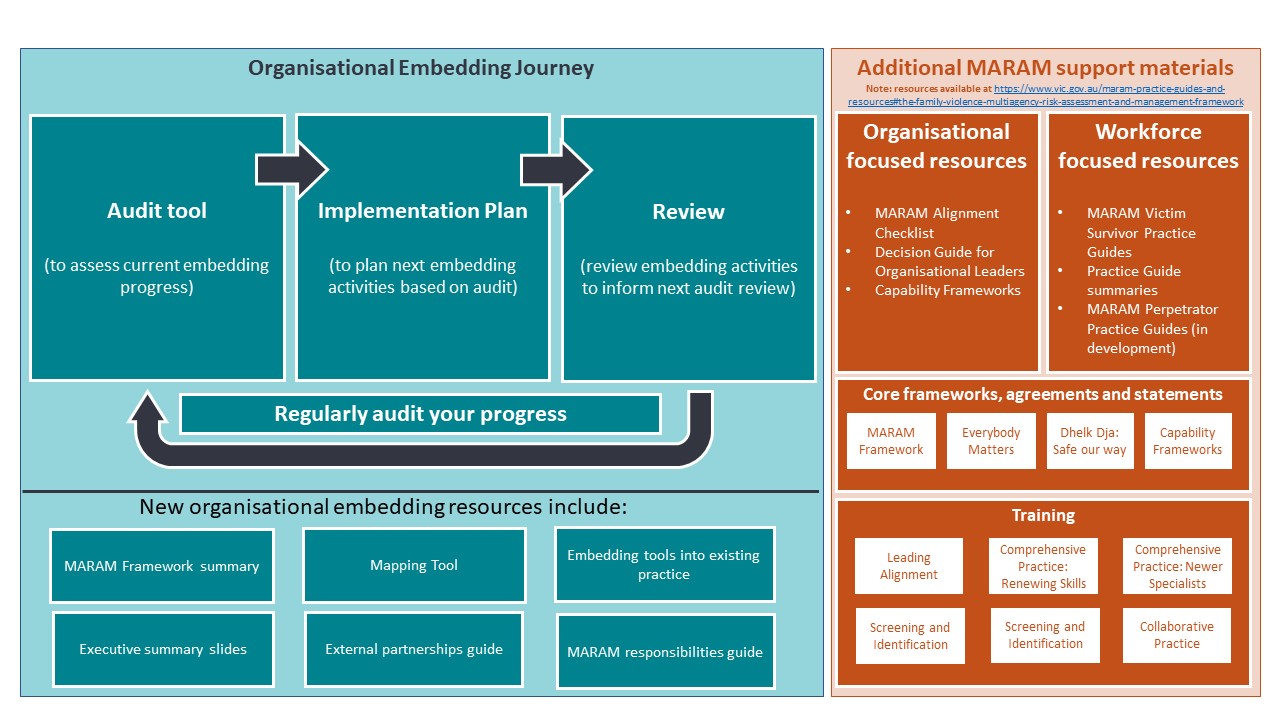The organisation embedding guide has been developed to support organisational leaders to meet their legislative requirements in the process of aligning policies and procedures to the MARAM framework. The language of ‘alignment’ supports the flexibility required for organisations to start from any point along the alignment scale, moving from positions of little to no alignment to positions of higher alignment over time. This approach to implementation is known as a ‘maturity model’The guide includes specific key actions and activities organisational leaders can undertake to determine responsibilities for staff across their organisation.
The organisational embedding guidance is structured around three core tools which can be used as part of an embedding journey:
- An organisational self-audit tool – this is used to conduct an internal self-audit of an organisation’s current alignment progress
- An implementation plan – this is used to step out embedding activities that the organisation will undertake
- An implementation review guide – this sets out three different ways to review the success of embedding activities which will inform the next organisational self-audit
Remember, leaders and practitioners can be further supported through attending MARAM training (see here for MARAM Training Calendar)
MARAM alignment organisation self-audit tool
The MARAM organisational self-audit tool is intended to prompt reflection on the alignment progress to date and identify and prioritise the next steps.
The audit tool contains a series of milestone statements, relevant to one of the MARAM Framework pillars.
Each milestone can be assessed against a progress scale, rated from no progress to significant progress, and there is space to take some reflective notes.
The audit will have helped you identify the weaker areas, or those areas that need more focus in the organisation’s alignment journey. The aim is to, over time, move all applicable milestone statement assessments from no progress to significant progress.
Implementation Plan
Once you have completed the audit, the next stage is to prepare an implementation plan.
The second core tool is a blank implementation template, in the form of a Gantt chart, with some example activities included. For example, if the organisation’s goal is to update policies and guidance with foundational knowledge, the steps may include:
- identify policies to update,
- draft the wording to be included in the update,
- obtain appropriate executive approval,
- launch the new documents and;
- communicate changes to staff.
MARAM Responsibility Role Mapping Tool
The implementation review guide is the third tool in the organisational embedding guidance. It contains 3 options on how to review the success of embedding activities. This includes
- A qualitative review – with a series of example questions
- A case file audit – with example checklists; and
- A quantitative review – with suggested data collection points
(Resource to support with mapping individual workers roles to their level of responsibility)
Overview of the Organisation Embedding Guide
Organisational embedding support
- If you have any queries about the organisational embedding guidance please email infosharing@familysafety.vic.gov.au
- These and other resources can be found here
- Please contact us if you have any questions familyviolence@vaada.org.au
